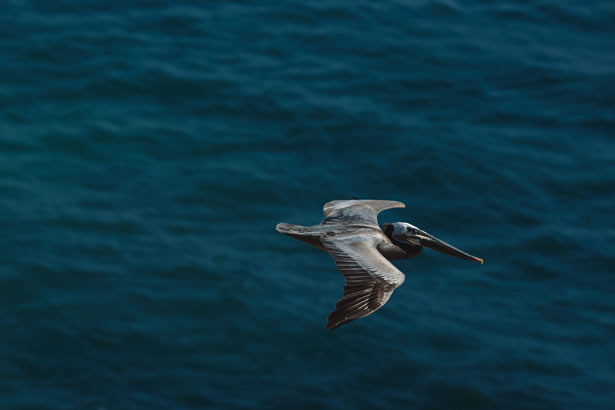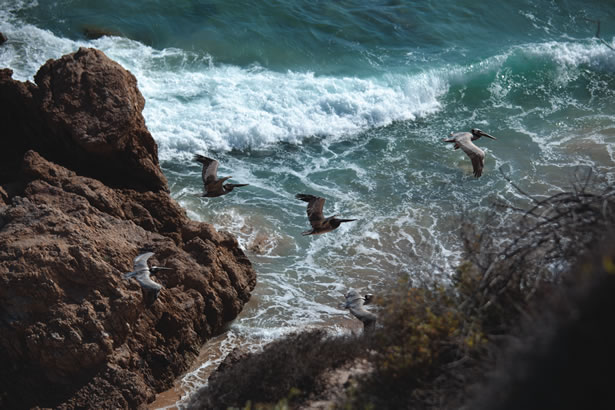Pity the poor pelican? No longer, as the once endangered bird makes a spectacular comeback.– By Aleta Walther
Whether sailing along the Newport harbor jetty, surfing the Wedge or relaxing atop Lookout Point, you’re likely to see pelican squadrons soaring high on thermal wind currents, gliding low on ocean updrafts or plunging head-on into the ocean’s depths for anchovies, sardines and mackerel.
Thanks to the bird’s former endangered species status, current protection under the Federal Migratory Bird Treaty Act and abundant fish, more and more California brown pelicans are making Newport Beach their summer vacation destination.
California brown pelicans range from Baja Mexico to Northern California and nest on the rocky islands along the coast where they have few natural predators. They hang out along the Orange County coast from May to October, head to their island rookeries to mate and rear their young between November and April. The only breeding colonies in the western United States are on West Anacapa and Santa Barbara islands in Channel Islands National Park.
“I am seeing more pelicans this year than in the past,” says Candice Hubert, a Newport Beach resident and an Orange County park ranger responsible for patrolling and protecting the county’s southern beaches. “Pelicans are a true conservation success story, having made an amazing comeback following the ban on DDT.”
Pelicans were placed on the U.S. Fish and Wildlife Endangered Species list in the early 1970s when it was determined that pesticides like DDT were decimating predatory bird populations. Research showed that when pelicans ate fish contaminated with DDT, their eggs were so thin that they broke during incubation. The 1972 ban on DDT, and ensuing public and private conservation measures, have resulted in the pelican pulling itself up from the brink of extinction. At the time of the pelican’s delisting from the Endangered Species list in 2009, it was estimated that there were more than 650,000 brown pelicans found across Florida and the Gulf and Pacific coasts, as well as in the Caribbean and Latin America. Pelicans are still protected under the Migratory Bird Treaty Act of 1918.
Along with the greater population of pelicans this year, we are seeing a greater number of sick and injured pelicans,” says Susan Kaveggia, a biologist and 14-year volunteer with the Wetlands and Wildlife Care Center in Huntington Beach. “We’re getting in a lot of hatchlings who are starving and weak because they haven’t perfected their hunting skills. We also take in five or six adults each week with fishing tackle injuries.”
The Wetlands and Wildlife Care Center is where Newport Beach Animal Control officers take rescued seabirds. The nonprofit center serves injured and orphaned wildlife, including seabirds that summer in Newport Beach or migrate along the Pacific flyway. Kaveggia specializes in pelican rescue and rehabilitation and when she releases pelicans back to the wild, she usually launches them along the coast of Newport Beach. Her preferred release location is Big Corona. The jetty is a popular resting site for pelicans and generally there are other pelicans in the area that released birds can meet up with.
“I’m no biologist, but I was fascinated watching those pelicans fly along the bluffs at Crystal Cove,” says Frank G. Scafidi, a Sacramento resident who vacations in Newport with his family each June.
Pelicans weigh 8 to 10 pounds, measure up to 4-1/2 feet long have a wingspan between 6-1/2 and 7-1/2 feet. Most people recognize the pelican by its foot-long bill and trademark throat pouch. Pelicans can live up to 25 to 30 years. Kaveggia said a pelican recently turned up alive and well that was banded in 1990 after being caught up in an oil spill off the coast of Huntington Beach.
The California brown pelican generally hunts for food within five miles of land, although young pelicans often loiter around Newport Harbor begging for handouts from fishermen, residents and tourists. A pelican will fly at heights as high as 70 feet, spot a school of small fish and plunge beakfirst into the waves and come up with a mouthful of fish in its 3 gallon pouch. Upon surfacing, the pelican tips his head forward to drain the water while retaining the fish. The brown pelican is alone among pelican species in plunge diving for its dinner.
The pelican is a Newport Beach icon. Many Newport Beach Restaurants have “Pelican” in their name: Rusty Pelican, Pelican Grill and the Pelican Courtyard. Several streets and housing developments also play off the pelican’s popularity, including communities within posh Newport Coast: Pelican Crest, Pelican Ridge, Pelican Point and Pelican Hill. There is also the Pelican Hill Golf Club and the luxurious Resort at Pelican Hill.
“Pelican Hill overlooks the Pacific Ocean along the coast of Newport Beach, where pelicans dwell abundantly and have long been a symbol of this seaside community,” says Ralph Grippo, president of the Irvine Company Resort Properties. “Situated amidst various neighborhoods that incorporate ‘pelican’ into their names, the Resort and Golf Club name was inspired not only by natural surroundings, but also by the vision of Pelican Hill as a social center of this community.” ,






